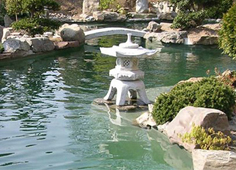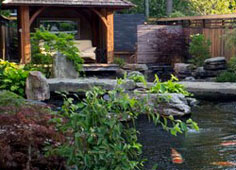 |
|---|
The Japanese garden is all about nature. You're trying to create a perfect piece of nature in miniature. So lines are curving and organic; stone and wood is left to weather; objects are placed in odd numbers. We have summarised what we feel are the 5 styles of Japanese Gardens.
If you are a purist you could follow a particular style, however for most people the elements of a Japanese Garden are enough to create the feeling that is required. Simplicity: Less is more. Japanese gardens are never fussy. This is especially true in rustic style gardens, where simplicity is revered. Balance: There should be a harmonious balance in all things: between vertical lines and horizontal; soft and hard; wet and dry; objects and space; high, mid and low level elements. There should also be a balance in terms of size: if your garden is small, the elements within it must be small; if it's large, you should use larger rocks and ornaments. Everything in balance. Asymmetry: You don't find symmetry in natural landscapes, so we don't use it Japanese gardens. Emptiness: Empty space is a feature in and of itself. If there are too many elements in your garden, it's definitely not going to feel Japanese. You need the proper balance between space and elements. Seasonality: Design your Japanese garden to be enjoyed all year round. Spring and summer are easy; but in autumn you can enjoy the falling leaves, and in winter, if you've planned the shape and structure of your garden carefully, it will look truly magnificent under its layer of snow. Meigakure: Meigakure means that you never see the whole garden at once. The different areas of the garden are partly concealed. This creates a feeling of space, nature, and mystery. |
|---|
| Ponds • Lakes • Water Gardens • Streams • Waterfalls • Fountains • Design • Construction • Repair • Maintenance • Filtration | © 2022 Classic Ponds & Japanese Garden Builders. All Rights Reserved |




